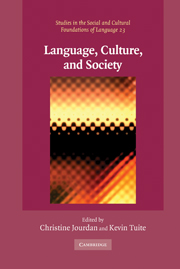Book contents
- Frontmatter
- Contents
- List of tables
- List of contributors
- Acknowledgments
- Introduction: Walking through walls
- 1 An issue about language
- 2 Linguistic relativities
- 3 Benjamin Lee Whorf and the Boasian foundations of contemporary ethnolinguistics
- 4 Cognitive anthropology
- 5 Methodological issues in cross-language color naming
- 6 Pidgins and creoles genesis: an anthropological offering
- 7 Bilingualism
- 8 The impact of language socialization on grammatical development
- 9 Intimate grammars: anthropological and psychoanalytic accounts of language, gender, and desire
- 10 Maximizing ethnopoetics: fine-tuning anthropological experience
- 11 Interpreting language variation and change
- References
- Index
- STUDIES IN THE SOCIAL AND CULTURAL FOUNDATIONS OF LANGUAGE
9 - Intimate grammars: anthropological and psychoanalytic accounts of language, gender, and desire
Published online by Cambridge University Press: 16 November 2009
- Frontmatter
- Contents
- List of tables
- List of contributors
- Acknowledgments
- Introduction: Walking through walls
- 1 An issue about language
- 2 Linguistic relativities
- 3 Benjamin Lee Whorf and the Boasian foundations of contemporary ethnolinguistics
- 4 Cognitive anthropology
- 5 Methodological issues in cross-language color naming
- 6 Pidgins and creoles genesis: an anthropological offering
- 7 Bilingualism
- 8 The impact of language socialization on grammatical development
- 9 Intimate grammars: anthropological and psychoanalytic accounts of language, gender, and desire
- 10 Maximizing ethnopoetics: fine-tuning anthropological experience
- 11 Interpreting language variation and change
- References
- Index
- STUDIES IN THE SOCIAL AND CULTURAL FOUNDATIONS OF LANGUAGE
Summary
Loco motion
The desert heat was oppressive. The flies were a constant presence on mouth, nostrils, and eyes. It is 1896. Baldwin Spencer and Frank Gillen are camped just west of Alice Springs, Australia. Gillen has arranged for Arrente men and women and their surrounding Aboriginal neighbors to gather nearby to perform a repertoire of their rituals in exchange for food, tobacco, tea and protection from pastoralists and police. Baldwin Spencer is a zoologist, Frank Gillen a telegraph operator. Both men aspire to be the intellectual leaders of an emergent Australian anthropology. So every day they direct photographers, scribble notes, sit with now nameless older Arrente men, who themselves sit and struggle to answer the river of questions Spencer and Gillen direct at them about the ceremonies they are performing. At times the heat must have overwhelmed everyone. But Spencer and Gillen were happy to sweat, to inhale flies, to stretch a cramped leg. They knew the unprecedented nature of what they were witnessing. Before their eyes was unfolding virtually the entire corpus of central desert male culture. The Arrente and their neighbors were performing and describing nearly every initiation, increase, and conception ceremony they owned. The ethnography Spencer and Gillen published based on these performances would become the touchstone of an ensuing generation of aspiring anthropologists.
At times Spencer and Gillen's eyes must have wandered from their writing and passed over the distended bellies of Arrente children and over the buckshot scarred backs of Arrente men and women.
- Type
- Chapter
- Information
- Language, Culture, and SocietyKey Topics in Linguistic Anthropology, pp. 190 - 206Publisher: Cambridge University PressPrint publication year: 2006
- 7
- Cited by

